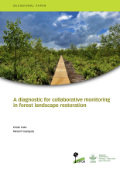Resource information
Forest landscape restoration (FLR) requires a long-term commitment from a range of stakeholders to plan the restoration initiative collaboratively and see it through successfully. This is only possible when the people involved whether they are landholders, indigenous groups, government entities, non-governmental organizations or other crucial actors come together to define common goals and monitor progress toward those goals. Collaborative monitoring can play a crucial role in these processes by providing a structured way to include diverse stakeholders in FLR, generate local buy-in and catalyze social learning. However, collaborative monitoring is new to many FLR planners and, while they may be interested in implementing collaborative monitoring, they may not know where to start. This diagnostic provides a systematic way for FLR planners to assess their FLR initiatives against a checklist of success factors. The diagnostic helps practitioners to: (1) determine whether they are ready for collaborative monitoring; (2) identify what elements need to strengthened; and (3) assess whether existing monitoring systems are on the right track. The diagnostic can be applied on at least two scales: it includes factors to be used at a specific FLR site and it outlines the factors that are intrinsic to a multi-level collaborative monitoring system. It consists of a core matrix of 42 success factors, plus suggestions for performing the assessment.


